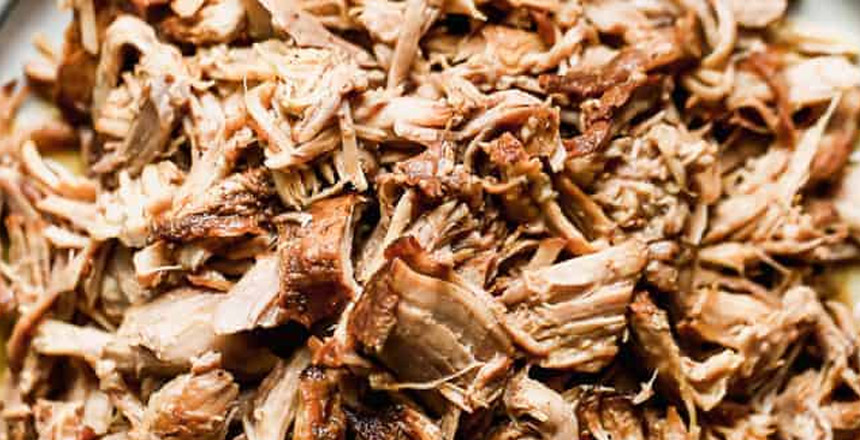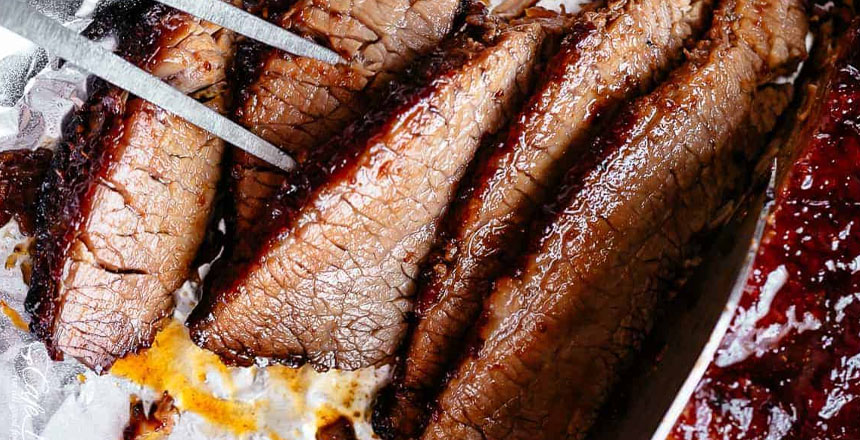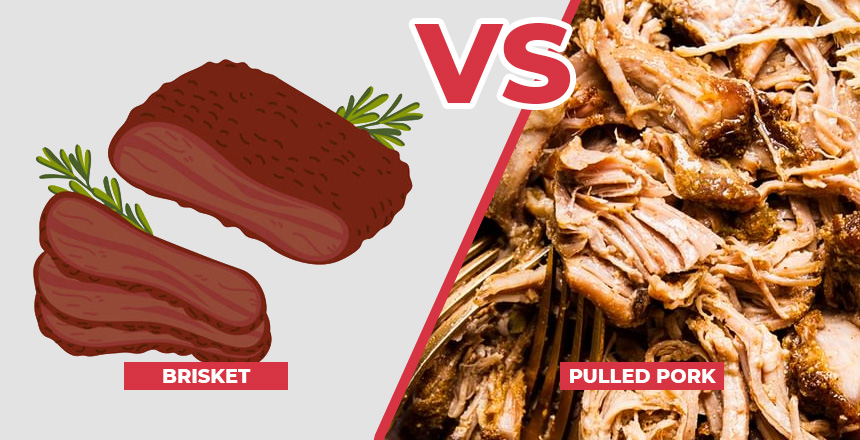Are you wondering which is better: pulled pork or brisket? It can be a difficult decision to make, especially when both dishes are so delicious and savory. Pulled pork and brisket both come from the same area of the pig, but each one requires different cooking methods in order for it to turn out perfectly.
We’ll get into the nitty-gritty details so that by the end of this post you will have all knowledge necessary to make an informed decision about what type of dish to serve at your next gathering. So pull up a chair – let’s take a closer look at pulled pork vs brisket.
Related:
- How to Smoke a Pork Butt for Delicious Pulled Pork
- Pork Butt Money Muscle: What is it
- When To Wrap Pork Butt
- How Long To Smoke A Brisket
What is Pulled Pork?

Pulled pork is typically made using pork shoulder, which is also known as pork butt or Boston butt.
The shoulder is a well-exercised muscle and has a lot of connective tissue, which makes it perfect for slow-cooking methods like roasting, smoking, or braising. The pork shoulder can be cooked as a whole roast, or it can be cut into smaller pieces, such as the shoulder picnic or the pork butt, which are both commonly used for pulled pork.
These cuts of meat have a higher fat content than some other cuts of pork, which makes them ideal for slow cooking, as the fat helps to keep the meat moist and flavorful as it cooks.
What is Brisket?

Brisket is a cut of beef taken from the breast or lower chest area of the cow. It’s a tough muscle that benefits from low and slow cooking methods like smoking or braising to break down the tough collagen in the meat.
The brisket is usually divided into two sections: the flat and the point. The flat is leaner and easier to slice, while the point is fattier and more flavorful, and is often used for making burnt ends.
Pulled Pork vs Brisket
Nutrition
Pulled pork and brisket are both delicious and popular barbecue types of meat, but they have some key differences in terms of nutrition.
Pulled pork is generally considered to be the healthier option, as it is lower in fat and calories than brisket. Pork shoulder, the cut of meat used to make pulled pork, contains less saturated fat than brisket, and the slow-cooking process allows much of the fat to be rendered out.
While both types of meat are good sources of nutrients, pulled pork is a slightly better choice when it comes to vitamins and minerals. Pork shoulder contains more iron, zinc, magnesium, and B vitamins than brisket, which are all essential nutrients that our bodies need to function properly.
Price
Brisket is typically more expensive than pulled pork, as it requires a larger portion of the cow and is usually more in demand. Brisket prices can also vary significantly depending on where you live and which cut you buy.
Pulled pork, on the other hand, is generally cheaper and more widely available, making it a good option for budget-conscious barbecue lovers.
Texture and Flavor
The texture of the two types of meat is another key difference between them. Pulled pork is tender, juicy, and succulent, while brisket has a firmer texture that needs to be broken down with long cooking times.
Brisket can also be served in different ways, such as thinly sliced or in chunks. Pulled pork is usually served in strands, as it has been shredded after cooking.
The flavors of pulled pork and brisket are also quite different. Pulled pork has a milder flavor that often takes on the flavors of any seasonings or sauces used to cook it, while brisket has a more intense, beefy flavor that is enhanced by the smoky flavors from wood smoking.
Cooking Time
The greatest difference between pulled pork and brisket is the cooking time. Brisket needs to be cooked slowly over low heat for several hours or even overnight, while pulled pork can usually be ready in just a few hours.
Also, smoked brisket requires more attention than smoked pulled pork, as it must be checked periodically to avoid overcooking.
Cooking Difficulty
In terms of cooking difficulty, brisket is generally considered to be more challenging to cook than pulled pork, due to its size and toughness. Brisket requires careful attention to temperature and timing to ensure that it is cooked properly and comes out tender and juicy.
Pulled pork, on the other hand, is more forgiving and can be cooked at a wider range of temperatures and for varying lengths of time.
Serving Suggestions
Pulled pork is usually served on sandwiches or buns, while brisket can be enjoyed alone or with a variety of side dishes. Brisket pairs well with roasted vegetables, mashed potatoes, coleslaw, and other classic barbecue sides.
It can also be used to make tacos, burritos, and other Mexican-inspired dishes. Pulled pork, on the other hand, is often served with mac and cheese, baked beans, or potato salad.
Both portions of meat can be used to make delicious stews, soups, and chili as well.
What Factors Should You Consider When Deciding Between Brisket and Pulled Pork For a Barbecue Meal?
When deciding between brisket and pulled pork for a barbecue meal, the most important factor to consider is the amount of time you have available. If you are short on time, pulled pork may be your best option as it can be cooked faster than brisket.
The flavor profile of the meats should also be taken into account. If you are a fan of bold, smoky flavors and want a classic barbecue experience, then brisket is likely your best bet. Pulled pork is milder in flavor and often takes on the flavor of any seasonings or sauces used to cook it.
Price is also an important consideration when choosing between the two types of meat. Brisket is typically more expensive than pulled pork, as it requires a larger portion of the cow and is usually more in demand.
You should also think about how you want to serve your barbecue meal. Pulled pork is usually served on sandwiches or buns, while brisket can be enjoyed alone or with a variety of side dishes.
At What Temperature Should You Smoke Brisket and Pork Shoulder?
The ideal temperature for smoking meat varies depending on the cut. Our team discovered through using this product that the recommended temperature is around 195°F, using a low-and-slow cooking method. This technique helps to break down the tough connective tissue in the meat, resulting in a tender and juicy finished product.
In contrast, for pork shoulder, a higher temperature of around 225°F to 250°F is recommended when smoking pulled pork. This higher temperature can help to speed up the cooking process, resulting in moist and succulent pork with a delicious smoky flavor.
FAQs
Is Pulled Pork and Brisket The Same Thing?
No, pulled pork and brisket are two distinct cuts of meat. Pulled pork is usually made from the pork shoulder, while the brisket is typically taken from the chest or lower belly of a cow. They have different flavors and cooking times, with brisket requiring more time to be cooked properly.
Is Brisket Harder to Cook Than Pulled Pork?
Brisket is generally more challenging to cook than pulled pork, requiring precise temperature and timing for a tender result. Pulled pork is more forgiving, with a wider range of cooking temperatures and times.
Is Brisket More Tender Than Pulled Pork?
In general, brisket is more tender than pulled pork due to its size and the cut of meat used.
What Cut of Meat Is Best for Pulled Pork?
The best cut of meat for pulled pork is the pork shoulder. This section of the animal contains a high amount of fat and connective tissue, which helps to keep the meat moist and flavorful during cooking.
Is Brisket The Toughest Meat?
Yes, brisket is considered to be the toughest cut of meat, due to its size and low-fat content. This makes it difficult to cook properly and requires a longer cooking time than other cuts of beef.
Is Brisket More Expensive than Pork?
Due to the high demand and longer cooking time required for brisket, it tends to be more expensive than pork shoulder.
Conclusion
The battle between pulled pork and brisket is a long and ongoing debate that has been ingrained in the BBQ culture since day one. Ultimately, there is no wrong answer – these two smoked types of meat have their own unique levels of flavor and texture, as well as cooking techniques that make each dish truly special.
Pulled pork is incredibly tender and juicy while brisket has bold flavors that are full of smokiness and savoriness. Both continue to remain favorites at barbecues across the nation, making homemade meals or catering services great options for throwing your own succulent gathering.
Ultimately the decision comes down to what you like in terms of texture, flavor, and smoke level.


